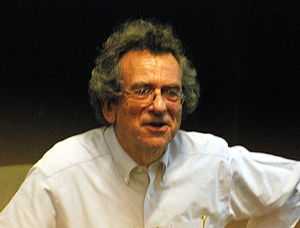David Mermin
From Wikipedia, the free encyclopedia
(For the founder of the international youth circus Circus Smirkus, see Rob Mermin.)
| David Mermin | |
|---|---|
 N. David Mermin | |
| Born |
30 March 1935 New Haven, Connecticut, USA |
| Residence | USA |
| Fields | Physicist |
| Institutions |
Cornell University University of California, San Diego University of Birmingham |
| Alma mater | Harvard University |
| Known for |
Mermin–Wagner theorem Mermin–Ho relation Lindhard–Mermin dielectric function Coining the term 'boojum' Mermin–Peres magic square |
| Notable awards |
Lilienfeld Prize (1989) National Academy of Sciences (1991) Klopsteg Memorial Award (1994) Majorana Prize (2010) |
Nathaniel David Mermin is a solid-state physicist at Cornell University best known for the eponymous Mermin–Wagner theorem, his application of the term "Boojum" to superfluidity, and for the quote "Shut up and calculate!"
Together with Neil Ashcroft, Mermin has written an esteemed textbook, Solid State Physics,[1] and numerous popularizations of physics and mathematics.
Mermin’s foot
Mermin has contributed to special relativity with two books and several articles. In It's About Time (2005) he suggests that the English foot be slightly modified:
- Henceforth, by 1 foot we shall mean the distance light travels in a nanosecond. A foot, if you will, is a light nanosecond (and a nanosecond, even more nicely, can be viewed as a light foot). …If it offends you to redefine the foot … then you may define 0.299792458 meters to be 1 phoot, and think "phoot" (conveniently evocative of the Greek φωτος, "light") whenever you read "foot".[2]
This adaptation of a physical unit is one of several ploys that Mermin uses to draw students into space-time geometry.
Notes
References
- Ashcroft, Neil W.; Mermin, N. David (1976). Solid State Physics. Holt, Rinehart and Winston. ISBN 0-03-083993-9.
- Mermin, N. David (2005). It's About Time: Understanding Einstein's Relativity. Princeton University Press. ISBN 978-0-691-12201-4.
External links
| Wikiquote has a collection of quotations related to: David Mermin |
- Mermin's homepage
- "What's wrong with those talks?" by David Mermin
- Mermin's festschrift in Foundations of Physics
- David Mermin at the Mathematics Genealogy Project
|
This article is issued from Wikipedia. The text is available under the Creative Commons Attribution/Share Alike; additional terms may apply for the media files.